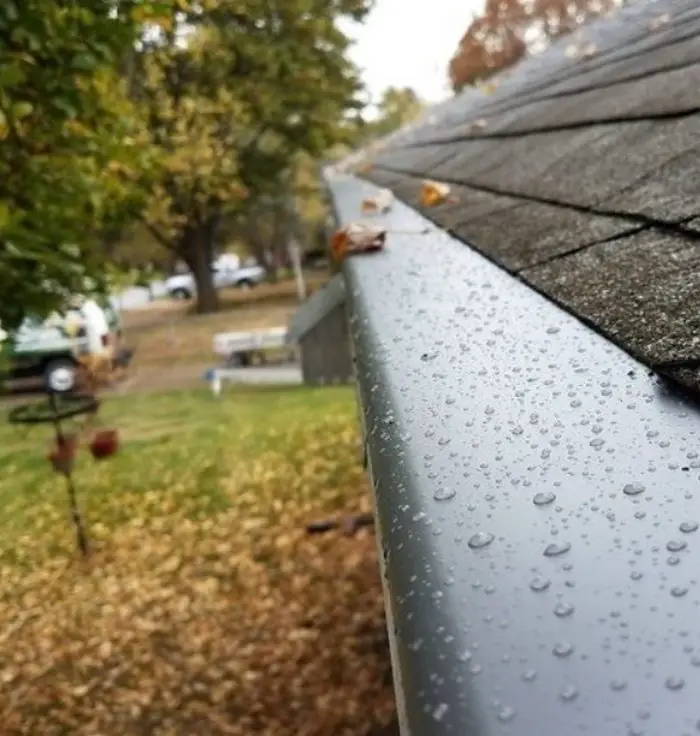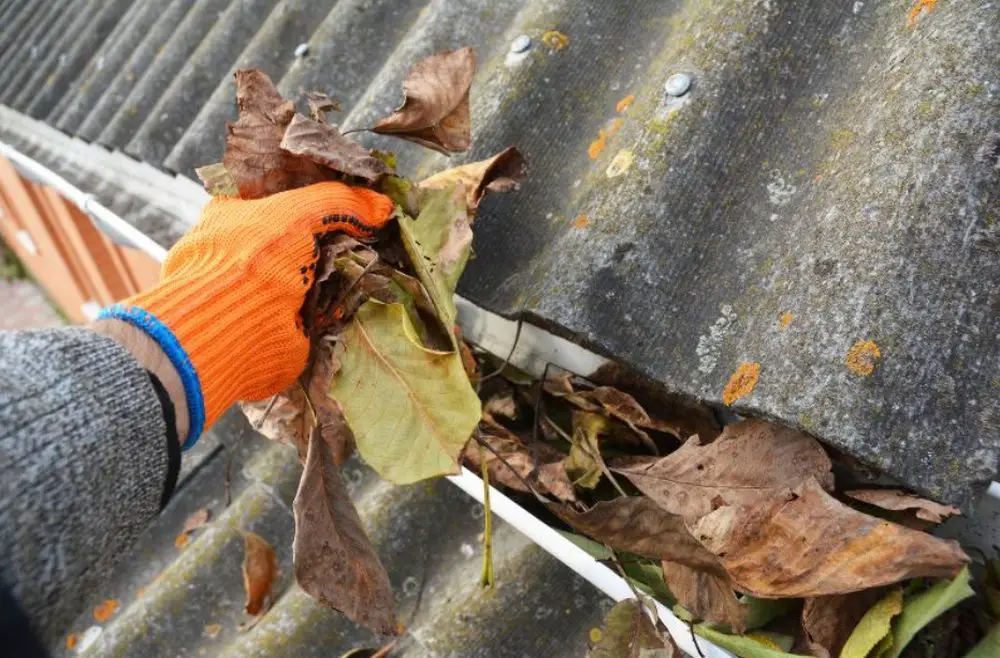Homeownership comes with a bunch of responsibilities, one of which involves maintaining a functional and efficient gutter system.
Gutter systems protect homes from water damage by guiding rainwater away from the home and its foundation. However, when neglected, they can become appealing homes for rodents and other critters.
Gutters clogged with leaves, twigs, and debris provide ideal nesting spots for pests. All of this can lead to many other problems (For example, think scratching through your facia and soffit into the attic. And yes, we’ve actually seen this happen).
Fortunately, there is an easy preventative.
Installing gutter covers can offer an effective solution to keep rodents and other critters out while enhancing overall gutter performance. This article explores gutter covers in-depth, focusing on their functionality, benefits, and selection criteria, particularly in terms of rodent control.

Contents
- 1 What are Gutter System Covers?
- 1.1 The Superiority of Solid Surface for Pest Control
- 1.2 A Complete Barrier
- 1.3 Water Flow Management
- 1.4 Material Selection Matters
- 1.5 Less Maintenance – Not No Maintenance
- 1.6 Selecting Appropriate Gutter System Guards for Your Area
- 1.7 The Gutter Covers Need to Match The Gutter
- 1.8 Roof Materials and Style
- 1.9 After the Install
- 2 Conclusion
What are Gutter System Covers?
Gutter covers, also known as gutter guards or leaf filters, are typically retrofit additions to an existing gutter system. They are generally designed to let water flow freely into the gutters when it rains or snows while keeping the debris out.
This prevents the water from backing up and overflowing the gutters. Regardless of the design, the main goal of all gutter cover designs is to keep gutters clear of debris like leaves, twigs, and other stuff that might clog them.
This result discourages rodents and other critters from building nests inside gutters since there’s no room for nesting materials to get in.
The Superiority of Solid Surface for Pest Control
There are two basic design concepts in gutter guards.
The solid surface design gutter covers act almost like an extension of the roof over the gutters, keeping debris out of the gutters while letting water through. Screens and meshes on the other hand act more like filters on top of the gutter.
There are pluses and minuses to both designs. However, as a general rule, the solid gutter cover design demonstrates superior performance in pest control within the gutters.
The reason for this is that when you have holes or perforations, even small ones, birds and pests are able to get a grip and pry on the system, creating tears or openings to get through. Solid surface, by its design, does not have these openings.
Consequently, it serves as a better protection for this specific problem. To better understand how solid gutter covers deter rodents from nesting in your gutters, let’s examine their key features:

A Complete Barrier
Solid gutter covers form a helmet across the top of the gutter.
The water follows the nose of the gutter cover and flows in from, in a sense, the side of the gutter, rather than the top. This simply leaves no space on the top for rodents to get in and potentially colonize within the gutter.
Additionally, this protection keeps out leaves, twigs, and other debris. This prevents that ideal nest-forming environment from developing in the first place.
Water Flow Management
The solid surface design is probably the best gutter guard system as it utilizes the physics principle of surface tension. In a sense, this forces the water to flow into the gutter system.
If the gutter cover is nose forward, meaning it sticks out just slightly past the edge of the gutter, which we recommend, this will also keep all debris out. If the gutter guard is not nose forward, it should likely still keep out rodents. But it is less certain.
Plus, there is an increased possibility of gutter clogs and increased maintenance for the homeowner.
Material Selection Matters
A high-quality gutter guard or gutter cover will be made with high-quality materials.
Avoid plastic and polyvinyl products or systems with components of plastic and polyvinyl. You’ll save money upfront, but pay for it in the results. These materials can be chewed through, become brittle in the sun, and don’t last as long.
Focus on leaf control systems constructed with aluminum, copper, and galvalume for longevity and endurance against rodents and other pests.
Less Maintenance – Not No Maintenance
Your goal with a leaf filter should always be to reduce maintenance while keeping the home protected.
This includes leaves and debris as much as rodents and critters, correct? For this reason, you want to look for a system that reduces maintenance as much as possible while controlling the water as much as possible.
With that being said, keep in mind that there is no such thing as a maintenance-free gutter protection system. Anyone who promises that either does not have enough experience to know how their system works in the real world or is bending on the truth. So when looking for a system to keep rodents away from your precious home, remember this.
If it sounds too good to be true, it probably is.

Selecting Appropriate Gutter System Guards for Your Area
The effectiveness of gutter covers can vary significantly based on where you live, due to differences in weather patterns and the types of tree debris common to an area. What works really well in one area may not work in another, and vice-versa.
This can lead to a lot of confusion for the consumer when doing online research. Adding to the problem are national articles that suggest a one-size-fits-all approach to gutter protection.
Use the following questions to help you make a good decision:
- Does this company and product have a good reputation in my city? Or are the good reviews strictly national…
- Was the product designed for this part of the country? For example, where is it manufactured? And very importantly for rodent control: Does this MAKE SENSE?
- When I look at this, is it obvious to me that rodents and other pests will not be able to enter or damage the system?
An example of this would be in Kansas City.
In this particular city, with its extreme seasons, incredibly varied tree debris, and critter numbers that sometimes border on biblical plague, a solid gutter cover has shown to be the ideal solution.
Once that’s been identified, look for the company with the best local reputation. (Think Google, BBB, Angi, Facebook, Home Advisor, etc.)
The Gutter Covers Need to Match The Gutter
This seems obvious, but it needs to be stated: It is important to carefully match the measurements of gutter covers with the actual gutters themselves.
Gutters can be found in 4”, 5”, 6”, 7” (although this size is rare), and 8” (usually commercial). Purchase your gutter helmet accordingly.
Roof Materials and Style
Just as important to size in your decision-making process is your roofing materials and style.
For example, there are some cover systems that work well in short gutter runs but may even be impossible to install on long gutter runs. Or, worse yet, will be installed anyway and leave large openings for critters and rodents to get access to your fascia and roofline.
Choose a system that can be customer-installed to your unique roofing materials and design. Don’t leave this to chance. Ask the person from whom you’re purchasing it.
After the Install
Look for a company that offers a warranty that would cover rodent and pest issues.
For example, if they get in the gutter and create a clog, the company should cover that. Remember, a warranty, including clogs created by rodents and critters, is as good as the company you get it installed from. So choose the company as carefully as the product.
How can you know this? Take the time to look for reviews where people were NOT totally satisfied. How did the company react? Did they care for the customer and stay professional?
Conclusion
The primary purpose of gutter guards is to keep gutters free from leaves, twigs, and other debris, thereby preventing clogs and ensuring the gutter system operates smoothly.
However, an equally important, yet often undervalued benefit, is their ability to prevent rodents, such as squirrels, raccoons, birds, and otherwise, from nesting within the gutter system. This is safer for your home, your gutters, and your family.
Therefore, this may be a solution you need to consider if you have had an issue with pests in your gutters, roofline and attic space. Just remember the key points we’ve covered in this article when making a decision: When considering gutter protection to keep out pests, stick to solid surface designs.
When choosing options within that design, make sure it can control your rainwater, is made with high-quality materials, works with your gutter size and roof, and is installed by a company that will come back out and take care of you if you have a problem.




